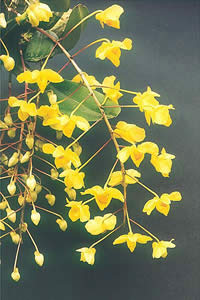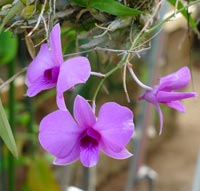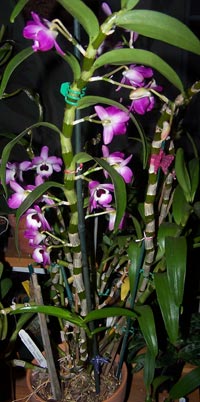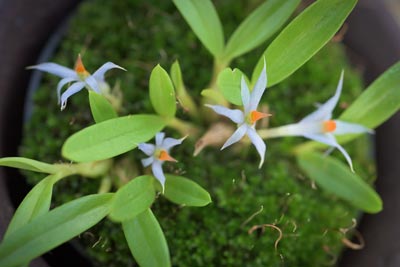


Dendrobium is genus of orchid in the family Orchidaceae. There are over 1200 recognized species of Dendrobium orchids and the floral trade has created an abundance of hybrids. Some species, for example Dendrobium nobile have been hybridized hundreds of times. Dendrobium orchids grow in a very many different habitats, so it is impossible to generalize their requirements. You can find wild Dendrobium orchids in the Australian outback as well as in an Asian tropical forest and the foothills of the Himalayan mountains. There are tropical rainforest Dendrobium, and species living in deciduous woodland at altitudes over 3000m. To offer correct Dendrobium care, you will need to consider your plant's natural environment. But sometimes information is scarce, or plants can be misidentified. It is important to pay attention to how your plant responds to the conditions in which you are keeping it. Below are some general, and more specific guidelines for looking after Dendrobium orchids as houseplants.
Dendrobium orchids are epiphytic or lithophytic in the wild, which means they grow attached to other plants (typically trees) or on rocks and stones. They generally do not root into the ground, so don't have access to the ground moisture as is the case with typical terrestrial plants. This fact is of critical importance when keeping Dendrobium (or any epiphytic orchid). They receive their moisture from rain landing upon their roots, and humidity in the air. For proper Dendrobium care, we must water adequately, but they must be allowed to dry between soakings. Letting orchids sit in wet media for long periods is a sure way to kill them.
The images below show a selection of Dendrobium plants growing epiphytes and lithphytes.
As opposed to monopodial orchids (like Phalaenopsis, Vanda etc), which basically grow from a single stem, sympodial plants like Dendrobium have a rhizome at the base, from which the stems (also called canes, but more precisely pseudobulbs) grow. The size and shape of these pseudobulbs can vary hugely from species to species, but in all cases their function is the same: they are basically storage for the plant, holding water and nutrients. The leaves typically grow in alternating layers on either side of the cane.
Dendrobium orchid care is generally quite easy, as long as you can offer good lighting conditions. Many people growing Dendrobium orchids as houseplants, actually take them outside for several months of the summer, before bringing them in before the first frosts. But if you are unable to offer these cool and dry conditions in winter the nobile-type plants will probably not flower for you.
Like most orchids, Dendrobium grow in the spring, flower in the summer, and then undergo a rest period for the winter before starting over. Humidity and temperatures drop during the winter, more significantly for some species than others. Dendrobium care indoors must take account these changes and attempt to replicate them. Read about 'soft cane' and 'hard cane' Dendrobium orchid care in the sections below.
Dendrobium canes vary from species to species, but some can get very tall. Because these epiphytes are used to growing with their roots in quite cramped conditions (for example the cracks in rocks), they like a small pot. These two facts can create a slight challenge for some Dendrobium plants, in that they become somewhat top-heavy. Plastic pots tend not to offer the weight to support a tall specimen, though they can be placed inside a planter in order to give them extra support. Larger canes may require some propping up, especially when the plant is newly repotted - bamboo stakes are perfect, whilst smaller plantlets can be bunched lightly with other stems with lightly tied string.
Your Dendrobium orchid will do best in an environment where the night temperature is lower than the day temperature. With so many species, and hybrids it is hard to suggest generalised temperature requirements. However, preferred daytime temperatures of tropical 'hard cane' species are generally in the range 75-85°F (24-29°C), with night time temperatures dropping to 60-65°F (15-18°C). 'Soft cane' (Nobile-type) Dendrobium prefer cooler temperatures still, down to 40°F (5°C) in winter. Protecting your orchid from temperature extremes is naturally an important part of Dendrobium orchid care. Occasional incidents can usually be handled by healthy and well established specimens, but prolonged exposure to unsuitable temperatures will be highly injurious for a Dendrobium orchid.
Dendrobium orchids can be divided into two distinct types, the 'hard cane' plants, typified by Dendrobium phalaenopsis, and the 'soft cane' species, typified by Dendrobium nobile. These species naturally have a lot in common, but because the two types inhabit quite different natural environments, their care will diverge somewhat
 Photo Chipmunk_1
Photo Chipmunk_1This Dendrobium is so-named due to certain similarities it has to the better known Phalaenopsis orchid. It has similar, thick, waxy leaves, and the somewhat flowers appear on a spike - the two plants are not actually related. This species is very widely hybridized, with hundreds of interesting and attractive varieties available.
This 'hard cane' Dendrobium hails from tropical forests in the very north east corner of Australia and New Guinea, so has less seasonal variation than Dendrobium nobile, below. It likes a warm bright environment, and regular feeding during the growing period; the winter rest period does not need a significant temperature drop to encourage flowering, though feeding should stop, and watering should be reduced; perhaps replaced by misting, unless the leaves or canes start to shrivel.
 Photo Airborne pilot
Photo Airborne pilotThis is a very well-known orchid, with huge numbers of cultivars available, with some very attractive flowers. Orchids of this type are often referred to as 'soft cane'. Generally easy to care for, and therefore very popular. Unlike Dendrobium phalaenopsis above, the flowers grow from the plant's canes, rather than from a flower spike. This species is also characterized by it's thin flexible leaves; quite unlike the foliage of D. phalaenopsis. Small buds appear on each node of the cane towards the end of winter. However, getting plants of this species to flower does require a little attention, and consideration of their natural growing conditions. Care for Dendrobium nobile indoors is not as simple as caring for some tropical orchids with less seasonal variation in temperature.
The natural habitat of Dendrobium nobile orchids is the deciduous forests in the foothills of the Himalayas, but also China, Vietnam, Thailand, Laos and Myanmar. They grow often at higher altitudes than many other orchid species and as such can tolerate significantly cooler temperatures than plants that inhabit lowland equatorial rainforests. If these plants do not experience a cool winter they will not flower, rather produce plantlets (keikis) instead of buds. The forests within which they live lose their leaves in winter, subjecting the plant to very bright, but cold and dry conditions.
So to exhibit best care, Dendrobium nobile should be given a winter break: this can be simulated by leaving these plants outdoors for a few weeks after flowering, temperatures as low as 50°F (10°C) are fine; naturally don't let these plants experience any frost. Stop feeding and watering the plant over the winter period (typically Halloween to Valentine's day), but position them with good light. They will certainly enjoy bright winter's sun. As stated, regular watering is not required, though some growers do continue to mist Dendrobium nobile to add a little humidity. If the canes start to shrivel, an occasional watering may be of benefit. Leaves of soft cane Dendrobium will drop, but pseudobulbs should be left in place, as they remain a store of water and nutrients.
The growing period of Dendrobium nobile is typically spring and summer. Plants should be kept warm, well fertilized with moderate to bright light.
As with all epiphytic orchids, best results are achieved with a very loose well-draining potting medium - this really is an essential part of Dendrobium orchid care indoors; plants with soggy compacted medium will surely suffer root rot and die. Fir bark has been used with Dendrobium with great success over many years; pots smaller than 6 inches, would probably do best with fine grade. If the pot is larger, you can use medium grade. More recently clay leca pebbles have proved an excellent alternative; they absorb water that the roots can access via capillary action, and do not biodegrade like bark. They perhaps dry a little too quickly though, and being completely inorganic offer no nutrients to the plant (despite the fact that we must fertilize our orchids, they do manage to extract small amounts of nutrients from the bark). Perhaps the best potting medium is a mixture of fir bark, leca balls and a little charcoal, just to keep the media fresh.
One other option is to grow this species as a true epiphyte, attached with bare roots to a word, cork bark or (most attractively) tree fern panels. Any bare rooted orchid grown in this way will need watering considerably more often than when potted; typically once (or even twice in hot weather) daily.
Dendrobium orchids are fairly sun tolerant but should be positioned away from the brightest mid day rays. These orchids love full morning and late afternoon sun, but do best if the light is somewhat filtered between 11 am and 3 pm. Soft cane types typically inhabit deciduous forests, so can actually experience brighter light in winter time, when the leaves of their host plants have fallen. As is usually the case, your orchid will tell you whether conditions are right: if the orchid is exposed to too intense midday sun, the leaves can turn yellow. If the orchid is placed in a spot where it is too dark, the leaves will turn from light green to dark green, and the plant may well fail to bloom.
Dendrobium orchids are epiphytic or lithophytic in the wild, and are therefore ill equipped for a life in a soggy plant medium. Precise watering requirements will depend on the plant media, and the environment in which they are kept. Let the potting medium dry out thoroughly before you give the orchid any more water. If in doubt, skip watering. Over-watering is more harmful to epiphytic orchids than underwatering. Yellowing Dendrobium leaves can be a sign of too much or too little water.
Good Dendrobium culture includes providing your plant with high nitrogen fertilizer 30-10-10 year round. For a normal strong fertilizer, one teaspoon of fertilizer per month will be adequate. Many orchids prefer to receive the nutrients in several smaller servings instead of being given all the nutrients in one single watering. It is perhaps best to feed half strength bi-weekly, or quarter strength weekly.
 Dendrobium nanarauticolum. Photo Snotch
Dendrobium nanarauticolum. Photo SnotchRepot your Dendrobium orchid every second year. This is most important, especially when a bark medium is used. After two years this will have degraded significantly, opening the possibility of souring. Whats more, soil micro-organisms will now be competing with the plant for nutrients. The best period for repotting is in spring, after blooming, though repotting should be performed immediately if the potting medium goes bad, e.g. becomes sour, infested with mould, or unable to drain properly. Dendrobiums will generally take three months or more for their roots to become established after repotting.
When Dendrobium specimens were originally considered by botanists in the early 19th century, they were thought to be hybrids because of the many similarities to other common orchid species around the world. In the 20th century, however, it was finally described as a separate genus.
The variance in flowers of easily available Dendrobium flowers is really quite incredible, certainly in terms of color, shape and patterning. Have a look at some of the beautiful Dendrobium orchids for sale below
A small selection of notable Dendrobium species: